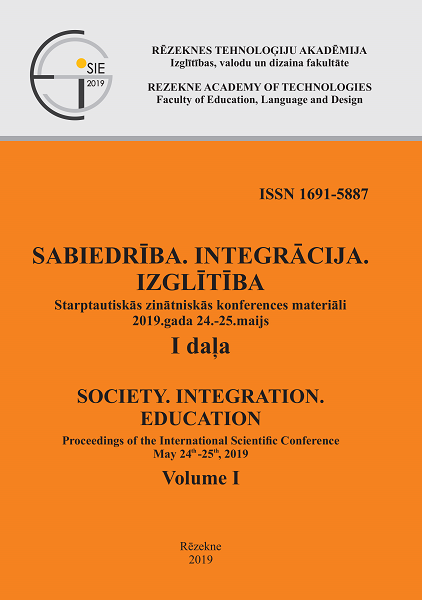CREATIVE PLATFORM METHODOLOGY: THEORETICAL FRAMEWORK FOR STUDENT CREATIVITY DEVELOPMENT IN COLLEGE STUDIES
DOI:
https://doi.org/10.17770/sie2019vol1.3848Keywords:
creativity, creativity development, Creative Platform, higher educationAbstract
In recent years, researchers have focused on the manifestations of students’ creativity, on the factors that impact its development, as well as on the conditions, means and methods that can facilitate students’ creativity in various fields of study. In the present investigation, the existing definitions of creativity, creativity development, the concept of Creative Platform and prior research conducted in the field have been analysed. The theoretical framework of the Creative Platform methodology, developed by the Danish researchers Christian Byrge and Søren Hansen (2009), is based on previous studies of creativity development (Amabile, 1998; Csikszentmihalyi, 2006; Stenberg, 1996; etc.). This methodology is currently used as a didactic model in higher education institutions across the globe, including Malta, Spain, China, and other countries. The present investigation presents a model based on the Creative Platform methodology. It is designed to develop students’ creativity in college studies via a specific teaching process during which students develop extra confidence, concentration, and motivation necessary for freeing themselves from the professional, social, or cultural stereotypes.Downloads
References
Amabile, T. (1998). How to Kill Creativity. Harvard Business Review (September-October), 176(5), 76-78.
Barevičiūtė, J. (2014). The aspects of creativity and creativeness in contemporary humanities and social sciences. Philosophy. Sociology 25(1), 19-28.
Barynienė, J. (2015). XXI a. kompetencijos: sėkmės formulė pradedantiesiems darbuotojams. Retrieved from: https://europa.eu/youth/lt/article/53/27648_en
Beresnevičius, G. (2006). Creative Problem Solving Using Algorithmic Methods. ACTA PAEDAGOGICA VILNENSIA, 17, 57-65.
Byrge, C., Hansen, S. (2014). Enhancing Creativity for Individuals, Groups and Organizations: Creativity as the Unlimited Application of Knowledge. Place of publishing: Frydenlung.
Byrge., C., & Hansen, S. (2015). The Creative Platform:A Handbook in Creative Processes for Education and Worklife. Place of publishing: Frydenlung.
Byrge., C., & Hansen, S. (2009). The Creative Platform: a new Paradigm for Teaching Creativity. Problems of Education in the 21st century, 18, 33-50.
Burkšaitienė, N. (2018). How can university learning environment contribute to students’ creativity? Lithuanian students’ perspective. Creativity Studies, 11(1), 162-171.
Csiksentmihalyi, M. (2006). A Systems Perspective on Creativity. In Jane Henry (Ed.), Creative Management and Development (5th Edition) (3-17). SAGE Publications Ltd.
Craft, A. (2008). Creativity in the school. Beyond Current Horizons: technology, children, schools and families. Retrieved from:
http://citeseerx.ist.psu.edu/viewdoc/download?doi=10.1.1.516.3765&rep=rep1&type=pdf
Craft, A, Cremin, T. & Burnard, P. (2008). Creative Learning 3-11: And How We Document IT. Trentham Books.
Kaufman, J. C. (2012). Counting the muses: Development of the Kaufman Domains of Creativity Scale (K-DOCS). Psychology of Aesthetics, Creativity, and the Arts, 6(4), 298-308.
Daujotytė, V. (2010). Kūrybingumas ir kūrybiškumo atpažinimas. Retrieved from: http://mokslasplius.lt/mokslo-lietuva/2006-2011/node/2450.html
Fasko, D. (2000 – 2001). Education and Creativity. Creativity Research Journal, 13(3-4), 317-327.
Fullan, M. (1998). The Forces of Change: Penetration Into the Depths of Education Reform. Vilnius: Tyto Alba.
Ganusauskaitė, A., Liesionis, V. (2009). Lithuanian Higher Education Perspective – Creative Society Developement. Journal of Management, 14(1), 33-39.
Girdzijauskienė, R. (2012). The Surroundings Benevolent for the Development of Creativity at Lithuanian Schools. Tiltai, 4, (79-91).
Grakauskaitė – Karkockienė, D. (2006). Changes in Pedagogical University Students' Creativity While Being Taught According to a Special Program. ACTA PAEDAGOGICA VILNENSIA, 17, 66-77.
Grakauskaitė – Karkockienė, D. (2016). Teachers Creativity and its Specific Expression in Educational Process. Pedagogy, 121(1), 5-22.
Grakauskaitė – Karkockienė, D. (2010). Training of Creativity: Theoretical and Practical Aspects. Educational Psychology, 21, 66-74.
Grakauskaitė-Karkockienė, D. (2013). Students’ creativity, personality traits, and birth order. ACTA PAEDAGOGICA VILNENSIA, 31, 84-94.
Guilford, J. P. (1950). Creativity. American Psychologist, 5(9), 444-454.
Guildford, J. P. (1987). Creativity research: Past, present and future. In S.G. Isaksen (Ed.), Frontiers of creativity research (34-36). New York: Bearly Limited.
Hennessey, B. A., Amabile, T. M. (2010). Creativity. Annual Review of Psychology, 61, 569-598.
Jucevičienė P. (2007). Mokytojo vaidmens paieškos mokymosi visą gyvenimą paradigmos kontekste. Mokymosi visą gyvenimą įgyvendinimo strategija – pedagogų kvalifikacijos tobulinimas. Mokytojų kompetencijos centras. Vilnius, MKC.
Lithuania’s Progress Strategy "Lithuania 2030". Retrieved from: https://lrv.lt/uploads/main/documents/files/EN_version/Useful_information/lithuania2030.pdf
Lund, M., Byrge, C., & Nielsen, C. (2017). From Creativity to New Venture Creation: A Conceptual Model of Training for Original and Useful Business Modelling. Journal of Creativity and Business Innovation, 3, 65-88. Retrieved from: http://www.journalcbi.com/uploads/3/1/8/7/31878681/from_creativity_to_new_venture_creation_a_conceptual_model_of_training_for_original_and_useful_business_modelling_by_morten_lund_christian_byrge_and_christian_nielsen.pdf
Obrazcovas, V. (2013). Mąstymo proveržis. Vilnius: MES.
Pedro, F. (2006). The new Millennium Learners: Challenging our Views on ICT and Learning: OECD‐CERI. Retrieved from: http://www.oecd.org/education/ceri/38358359.pdf
Penkauskienė, D. (2016). Links between Critical and Creative Thinking. Social theory, empirics, politics and practice, 13, 90-104.
Rakauskaitė, E. D. (2014). Development of Creativity – an Investment to the Creative Society, Social Technologies, 4(2), 333-347.
Rimkutė – Jankuvienė, S. (2016). Kūrybiškumo teorinis diskursas. Kūrybiškas mokytojas – kūrybiški mokiniai (5-14). Klaipėda: Klaipėdos universiteto leidykla. Retrieved from: http://lyra.365.lt/leidiniai/kurybiskas-mokytojas/kurybiskas.pdf
Rhodes, M. (1961). An Analysis of Creativity. The Phi Delta Kappan, 42(7), 305-310.
Robinson, K. (2011). Out of Our Minds: Learning to be Creative. Oxford: Capstone. Retrieved from: http://www.fredkemp.com/5365su12/robinsonchpt123.pdf
Simonton, D. K. (2000). Creativity: Cognitive, Personal, developmental, and Social aspects. American Psychologist, 55(1), 151-158.
Simplicio, J. S. C. (2000). Teaching classroom educators how to be more effective and creative teachers, Education, 120(4), (675‐680).
Starko, A. J. (2014). Creativity in the classroom. Schools of Curious Delight (5th Edition). Routledge: Taylor & Francis Groups. New York.
Sternberg, J. R. (2006). The Nature of Creativity. Creativity Research Journal. 18(1), 87-98.
Sternberg, R. J., & Williams, W. M. (1996). How to Develop Student Creativity. Alexandria, VA: Association for Supervision and Curriculum Development (ASCD).
Torrance, E. P. (1999). Torrance tests of creative thinking: Norm technical manual. Bensenville, IL: Scholastic Testing Services.
Urban, K. K. (2014). From creativity to Responsible Createlligence. Gifted Education International, 30(3). 237-247.
Valantiejūtė, L. (2009). Edwardas de Bono: Taip ir neišmokome kūrybingai mąstyti. Retrieved from: http://www.bernardinai.lt/straipsnis/2009-10-29-edwardas-de-bono-taip-ir-neismokome-kurybingaimastyti/34330
Weisberg, R. W. (2006). Creativity: Understanding Innovation in Problem Solving, Science, Invention, and the Arts. Hoboken, NJ: Wiley.


